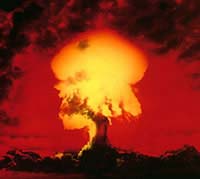Sperm and eggs fall foul of fallout

470 nuclear weapons were detonated in Kazakhstan between 1949 and 1989 <br>© SPL <br>
Nuclear tests up gene mutation risk.
People in the remote former Soviet republic of Kazakhstan who were exposed to fallout from nuclear-weapon tests have more genetic mutations in their eggs and sperm than normal, researchers have found1. Their children could inherit health defects caused by such mutations.
The Soviet Union detonated 470 nuclear weapons at the Semipalatinsk nuclear-testing site between 1949 and 1989, many above ground. The blasts showered radioactive dust over a 100-kilometre area. Inhabitants received up to one-fifth of a lethal radiation dose.
This has reputedly caused cancer and other health problems amongst the area’s sparse population. But medical evidence has been meagre.
Scientists do not know whether this type of radiation exposure causes genetic damage in humans, and if so, whether the damage is passed on to children. The three generations of affected individuals now living in Kazakhstan enabled Yuri Dubrova of the University of Leicester, UK, and his team to start estimating the harm that has been caused.
The researchers found double the normal rate of genetic changes in people’s sperm and eggs. These cells form future offspring, so the mutations are likely to be hereditary.
“[Until recently] no one had been able to measure the genetic effects of exposure,” says Dudley Goodhead, who directs the MRC Radiation and Genome Stability Unit in Harwell, UK. “[The Kazakhstan work] indicates that mutations can occur at an enormously high rate.”
The researchers still do not know whether this genetic damage has caused health problems for the area’s children, or whether it will do so in the future, because mutations only rarely result in disease. “It wouldn’t be surprising,” says Goodhead. But researchers agree that any effects of inherited mutations are likely to be small and difficult to detect against the normal incidence rates of cancer and disease.
People directly exposed to radiation by the atomic-bomb detonations in Japan during the Second World War and by nuclear accidents such as Chernobyl, suffer increased rates of cancer. But the common perception that exposed individuals bear children with deformities is not backed up by scientific study.
Measuring the legacy
Measuring the mutation rate caused by radiation has proved difficult, explains Goodhead. Any given gene will be affected rarely, so only a large population would reveal an accurate frequency – and no such human population exists.
Dubrova instead looked at DNA fingerprints, which show many short sections of DNA that spontaneously vary, or mutate, from generation to generation. In 1996, he showed that children born in Belarus after the Chernobyl disaster have a higher rate of such mutations2.
In the Semipalatinsk population, the team found that the more years people were exposed to the radiation, the greater their mutation rate.
Knowing how the rate varies with radiation dose could be used to screen populations for suspected exposure. “We’d love to know that,” says David Rush, who studies the health effects of radiation at Tufts University in Boston.
Test ban
Alongside the Soviet Union, the United States carried out above-ground nuclear tests in the Nevada desert; both nations ceased testing with the Moscow treaty in 1963. The Semipalatinsk site was closed in 1989 as part of the campaign to establish a comprehensive test-ban treaty. This treaty has yet to be ratified.
The Kazakhstan population has since fought for financial and health compensation, and Dubrova hopes that his work might help their cause: “I would be delighted if that were the case,” he says.
References
- Dubrova, Y.E. Nuclear weapons tests and human germline mutation rate. Science, 295, 1037, (2002).
- Dubrova, Y.E. et al. Human minisatellite mutation rate after the Chernobyl accident. Nature, 380, 683 – 686(1996).
Media Contact
More Information:
http://www.nature.com/nsu/020204/020204-10.htmlAll latest news from the category: Ecology, The Environment and Conservation
This complex theme deals primarily with interactions between organisms and the environmental factors that impact them, but to a greater extent between individual inanimate environmental factors.
innovations-report offers informative reports and articles on topics such as climate protection, landscape conservation, ecological systems, wildlife and nature parks and ecosystem efficiency and balance.
Newest articles

Global Genetic Insights into Depression Across Ethnicities
New genetic risk factors for depression have been identified across all major global populations for the first time, allowing scientists to predict risk of depression regardless of ethnicity. The world’s…

Back to Basics: Healthy Lifestyle Reduces Chronic Back Pain
Low back pain is a leading cause of disability worldwide with many treatments, such as medication, often failing to provide lasting relief. Researchers from the University of Sydney’s Centre for Rural…

Retinoblastoma: Eye-Catching Investigation into Retinal Tumor Cells
A research team from the Medical Faculty of the University of Duisburg-Essen and the University Hospital Essen has developed a new cell culture model that can be used to better…



